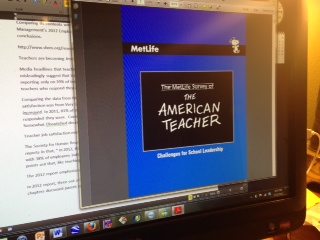The annual MetLife Survey of the American Teacher, based on surveys of teachers and principals conducted between October and November, 2012, has just been released. Comparing its contents with last year’s report, media coverage, and the Society for Human Resource Management’s 2012 Satisfaction and Engagement Report guide me to the following observations.
Teachers are becoming less satisfied but not dissatisfied with their jobs.
Media headlines that teacher job satisfaction is on a downward trend are literally true, but misleadingly suggest that teachers are becoming dissatisfied with their careers. This comes from including only the 39% of teachers who respond that they are Very Satisfied and ignoring the 43% of teachers who respond that they are Somewhat Satisfied.
Comparing data from the 2011 and 2012 reports reveals that all the shift in teacher satisfaction was between the Very Satisfied and Somewhat Satisfied categories, and that there was no movement into the dissatisfied category.
In fact, overall teacher satisfaction has increased! In 2011, 81% of respondents said they were Very or Somewhat Satisfied. But in 2012 that number rose to 82%. Correspondingly, the percentage of teachers reporting that they were Very or Somewhat Dissatisfied decreased by 1%.
Additional questions, like “Compared to last year, how satisfied are your with your job?” and “Do you think you are more or less satisfied with your job than other teachers?” could yield a wealth of interesting data.
Teacher job satisfaction exactly mirrors that of other careers.
Society for Human Resource Management reports that “In 2012, 81% of U.S. employees reported overall satisfaction with their current job, with 38% of employees indicating they were Very Satisfied and 43% Somewhat Satisfied.” The report points out that, as in teaching, these numbers are down from record highs in 2008 and 2009.
I would love to know how my colleagues would answer a question like “Compared to friends and acquaintances in other careers, how satisfied are you with teaching?” Or even, “Considering other careers practiced by friends and acquaintances, with whom would you most like to change places?”
The 2012 MetLife report emphasizes leadership role.
In the 2012 report, three out of four chapters discuss leadership in schools. Much of the discussion focuses on principals, but teacher leadership is also explored. Forty-seven percent of teachers responded that they are Extremely/Very/Somewhat interested in hybrid positions that combine part-time teaching with other responsibilities. This is in sharp contrast to the 13% who respond that they are Extremely/Very/Somewhat interested in becoming a principal.
The discussion on teacher leadership concentrates on teachers who have formal leadership roles in schools, but neglects to address teachers who develop ideas and lead outside of a designated responsibility. Barnett Berry addresses this in his comment on the report: “It is time to create more time for teachers to incubate and execute their own ideas – making the job of “principal-ing more manageable and encouraging more of our best teachers to lead without leaving.” He praises the report for highlighting teachers’ interest in hybrid roles.
Here, a question to ask might be, “If you imagine yourself in a hybrid role, is it likely to be a formal leadership role or one that you have ‘incubated and executed’ from your own ideas?”
Conclusion
Combining observations about teacher job satisfaction and leadership roles, here’s one last question: “What cause-effect relationships present themselves when you consider your job satisfaction together with your role in the leadership of your school?”









